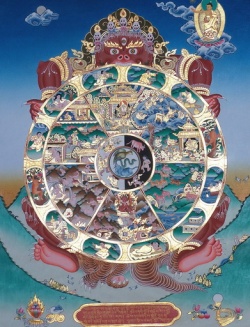Twelve-linked chain of causation
twelve-linked chain of causation
[十二因縁・十二縁起] (Jpn juni-innen or juni-engi )
Also, twelve nidanas or twelve-linked chain of dependent origination. An early doctrine of Buddhism showing the causal relationship between ignorance and suffering. The Sanskrit word nidana means cause or cause of existence. Shakyamuni is said to have taught the twelve-linked chain of causation in answer to the question of why people have to experience the sufferings of aging and death. Each link in the chain is a cause that leads to the next.
The first link in the chain is ignorance (Skt avidya ), which gives rise to
(2) action (samskara) (also, volition or karmic action);
(3) action causes consciousness (vijnana), or the function to discern;
(4) consciousness causes name and form (nama-rupa), or spiritual and material objects of discernment;
(5) name and form cause the six sense organs (shad-ayatana);
(6) the six sense organs cause contact (sparsha);
(7) contact causes sensation (vedana);
(8) sensation causes desire (trishna);
(9) desire causes attachment (upadana);
(10) attachment causes existence (bhava);
(11) existence causes birth (jati); and
(12) birth causes aging and death (jara-marana).
The twelve-linked chain of causation is seen in two ways: the way of transmigration and the way of emancipation. From the viewpoint of the way of transmigration, ignorance gives rise to action, action causes con-sciousness, etc.; finally, birth causes aging and death as explained above. Thus one is caught in the cycle of delusion and suffering. On the other hand, from the viewpoint of the way of emancipation, if ignorance is wiped out, so is action; if action is wiped out, so is consciousness, etc.; finally, if birth is wiped out, so are aging and suffering. In short, if one eliminates ignorance, which is the source of suffering, one becomes free from the cycle of delusion and suffering, or attains nirvana.
The Great Commentary on the Abhidharma, a text of the Sarvastivada school, views the twelve-linked chain of causation as operating over the three existences of life, meaning one's past, present, and future existences.
(1) Ignorance and
(2) action are together interpreted as the causes created in a past life;
(3) consciousness through
(7) sensation, as the effects manifest in the present life;
(8) desire through
(10) existence, as the causes created in the present life; and
(11) birth and
(12) aging and death, as the effects manifest in the next life. Aging and death in this life are thus the results of causes formed in a previous life.
